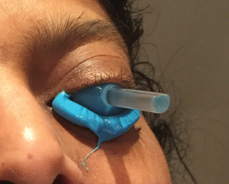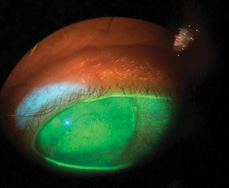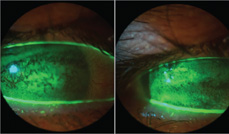Impression-based contact lenses expand treatment options for challenging cases

Millions of people worldwide suffer from debilitating conditions that impair their vision and require them to wear specialty contact lenses. Unfortunately, there are times when these custom devices may not work.
In addition, clinical and practical challenges exist with fitting scleral lenses. Indeed, widespread adoption of these lenses is limited due to a relatively steep learning curve for fitters and the time-intensive tting process involved. However, as the following case illustrates, newer methods may simplify the fitting process, making it easier than ever to fit the most tough-to-treat cases.
Rethinking treatment
A 67-year-old man presented with facial nerve paralysis in the right eye secondary to an acoustic neuroma. As a result, his blink reflex was limited, and he developed severe exposure keratitis and central corneal scarring. The patient’s best corrected visual acuity on presentation was 20/200 with glasses. He was fit in a custom scleral lens, but the inability to blink caused the lens to fog within minutes. BCVA with the scleral lens was 20/70, and the patient reported discomfort with the lens.

Source: Vishakha Thakrar, OD, FAAO, FSLS


Because the custom scleral lens did not provide adequate vision correction, fogged rapidly and was uncomfortable, we suggested an alternative method of correction, the EyePrintPro prosthetic device (EyePrint Prosthetics). EyePrintPro is similar to a standard scleral lens insofar as it is made of the same FDA-approved oxygen permeable materials, and the fit vaults the cornea while landing on the sclera. However, instead of using a series of curves, the device is designed by using Elevation Specific Technology to exactly match the unique irregularities of the individual eye. The resulting lens is like a fingerprint individualized to each patient.
The process begins with an impression mold, using a polyvinyl siloxane material. Doctors then send the impression to a dedicated lab for 3-D scanning. The scanned data is then used to produce a lens that matches the impression exactly and, therefore, fits perfectly. This is what makes the impression-based technology so different compared to previous options — it is a completely custom scleral lens that matches the exact contours of the anterior surface of the globe.
Beyond comfort and ease of fitting, impression-based lenses allow for improved optics in diseased corneas. Due to the precise nature of the back surface fit, high quality and individualized optics can be placed on the front surface of the device.
A better outcome
The patient’s best-corrected visual acuity with the impression-based lens was 20/30, and he reported minimal fogging. In addition, the epitheliopathy was reduced from grade 4 confluent to trace corneal staining.
He was able to better tolerate the impression-based lens compared to the other scleral lens because the elevation-specific impression process allows for a more precise t. Another important factor in this case relates to the fact that the lens was treated with Hydra-PEG technology (Tangible Science), a coating that improves wettability, increases lens surface water retention and minimizes lens fogging. This enabled the patient to wear the lens for longer periods without blurred vision, and he applied fewer articial tears as a result.
Treating other conditions
Because impression-based lenses are not constrained to typical fabrication, they can be made for eyes with the most difficult conditions where other options have failed. Certified practitioners have successfully fit the lenses on patients with many types of irregular corneal conditions, including keratoconus, traumatic scars, pellucid marginal degeneration, chemical burn, post-LASIK, PRK- or RK-related irregular astigmatism, corneal transplant, pinguecula, pterygium, severe ocular surface disease and post-glaucoma surgery.
At our clinic, we have embraced this novel technology and approach. Our outcomes for patients fitted from 2014 to 2016 were recently published in a peer-reviewed journal (Nguyen et al). Our retrospective review of patients who had undergone EyePrintPro ttings at Vaughan Family Vision Care included 14 eyes from 10 patients. Patient demographics, medical and ocular history, indications for tting, duration of lens wear, symptoms and BCVA — before and after tting — were analyzed. Indications for tting of the EyePrintPro included:
- limbal stem cell deciency;
- post–PRK decentered ablation;
- pellucid marginal degeneration;
- Stevens-Johnson syndrome;
- keratoconus;
- dry eye;
- neurotrophic keratitis;
- exposure keratitis from facial nerve paralysis; and
- post–RK symptoms.
The majority of eyes (eight of 14) had failed either corneal contact lens wear or conventional scleral lens wear because of inadequate comfort, vision or a compromise to the cornea and ocular surface.
Seventy-one percent of patients presented with dry eye, 50% presented with discomfort, 43% presented with pain, and 50% presented with redness. All eyes experienced improvement of their symptoms of dry eye, redness and/or pain. Seven (88%) of the eight eyes that were previous lens wearers before the impression-based lens experienced greater comfort and ability to wear the devices for a longer period during the day.
All eyes presented with blurry vision. Mean best-corrected logMAR visual acuity before impression-based lens tting was 0.430 (Snellen 20/54, range 20/ 20 to 20/200). However, with impression-based lenses, 93% experienced a visual improvement, with 20/30 or better achieved in all 14 eyes. After tting, mean logMAR visual acuity was 0.03 (Snellen 20/21, range 20/10 to 20/60, p = .001).
Common complications of scleral lens wear, including bulbar redness, conjunctival blanching or impingement, and scleral lens adhesion, were reduced or eliminated in this case series. Two eyes (14%) experienced fogging, and the lenses needed to be cleaned after 4 to 6 hours of wear. However, all patients reported satisfaction with the impression-based lenses. No complications related to the use of the impression-based lens (corneal opacifications or infections) were identified in the study.
A less invasive solution
Many of the diseases that we have treated with impression-based lenses had otherwise limited treatment options. For example, we have selected these lenses in lieu of performing deep anterior lamellar keratoplasty or penetrating keratoplasty, as these more invasive options would have subjected the patients to intraoperative and rejection risks and would have required long-term steroids. For these and other reasons, primary eye care providers should be aware that this new therapeutic scleral lens adds to the armamentarium of options for patients who have failed with other lenses, have severe ocular surface disease or have conditions in which surgical intervention can be delayed or obviated.
References:
Nguyen MTB, et al. Can J Ophthalmol. 2018;doi:10.1016/j.jcjo.2017.07.026.
For more information:
Vishakha Thakrar, OD, FAAO, FSLS, is residency-trained in cornea, contact lenses and refractive surgery management. She is the owner of Vaughan Family Vision Care, a specialty contact lens practice in Vaughan, Ontario, where she primarily sees patients with corneal and ocular surface disease. She can be reached at: ThakrarV@gmail.com.
Disclosure: Thakrar reports she is an advisory board member for Allergan and Novartis and a speaker for Bausch + Lomb Specialty Vision Products and Precision Technology.
